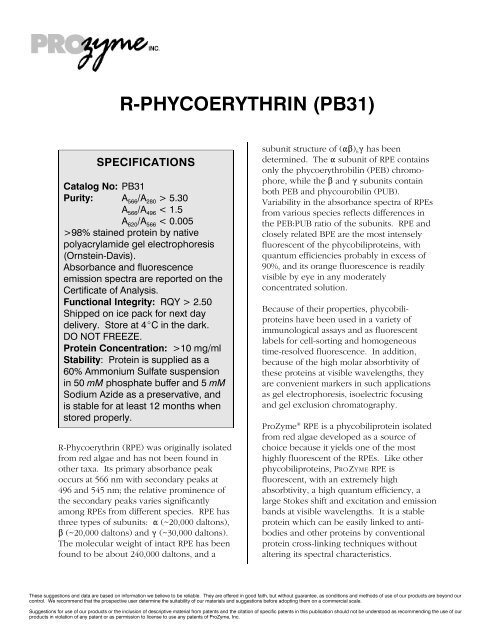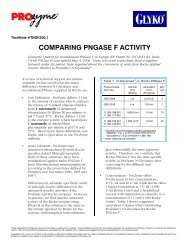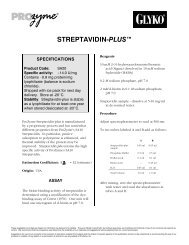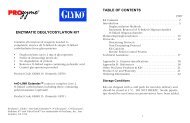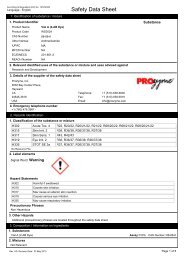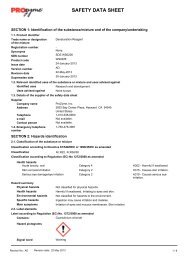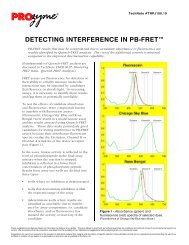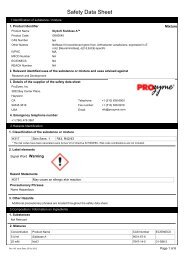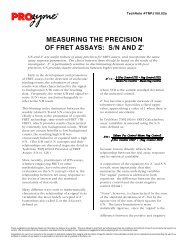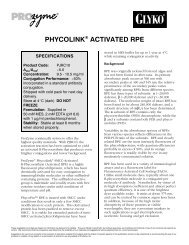R-PHYCOERYTHRIN (PB31) - ProZyme
R-PHYCOERYTHRIN (PB31) - ProZyme
R-PHYCOERYTHRIN (PB31) - ProZyme
You also want an ePaper? Increase the reach of your titles
YUMPU automatically turns print PDFs into web optimized ePapers that Google loves.
R-<strong>PHYCOERYTHRIN</strong> (<strong>PB31</strong>)SPECIFICATIONSCatalog No: <strong>PB31</strong>Purity: A 566/A 280 > 5.30A 566/A 496 < 1.5A 620/A 566 < 0.005>98% stained protein by nativepolyacrylamide gel electrophoresis(Ornstein-Davis).Absorbance and fluorescenceemission spectra are reported on theCertificate of Analysis.Functional Integrity: RQY > 2.50Shipped on ice pack for next daydelivery. Store at 4C in the dark.DO NOT FREEZE.Protein Concentration: >10 mg/mlStability: Protein is supplied as a60% Ammonium Sulfate suspensionin 50 mM phosphate buffer and 5 mMSodium Azide as a preservative, andis stable for at least 12 months whenstored properly.R-Phycoerythrin (RPE) was originally isolatedfrom red algae and has not been found inother taxa. Its primary absorbance peakoccurs at 566 nm with secondary peaks at496 and 545 nm; the relative prominence ofthe secondary peaks varies significantlyamong RPEs from different species. RPE hasthree types of subunits: (~20,000 daltons), (~20,000 daltons) and (~30,000 daltons).The molecular weight of intact RPE has beenfound to be about 240,000 daltons, and asubunit structure of () 6 has beendetermined. The subunit of RPE containsonly the phycoerythrobilin (PEB) chromophore,while the and subunits containboth PEB and phycourobilin (PUB).Variability in the absorbance spectra of RPEsfrom various species reflects differences inthe PEB:PUB ratio of the subunits. RPE andclosely related BPE are the most intenselyfluorescent of the phycobiliproteins, withquantum efficiencies probably in excess of90%, and its orange fluorescence is readilyvisible by eye in any moderatelyconcentrated solution.Because of their properties, phycobiliproteinshave been used in a variety ofimmunological assays and as fluorescentlabels for cell-sorting and homogeneoustime-resolved fluorescence. In addition,because of the high molar absorbtivity ofthese proteins at visible wavelengths, theyare convenient markers in such applicationsas gel electrophoresis, isoelectric focusingand gel exclusion chromatography.<strong>ProZyme</strong> RPE is a phycobiliprotein isolated®from red algae developed as a source ofchoice because it yields one of the mosthighly fluorescent of the RPEs. Like otherphycobiliproteins, PROZYME RPE isfluorescent, with an extremely highabsorbtivity, a high quantum efficiency, alarge Stokes shift and excitation and emissionbands at visible wavelengths. It is a stableprotein which can be easily linked to antibodiesand other proteins by conventionalprotein cross-linking techniques withoutaltering its spectral characteristics.These suggestions and data are based on information we believe to be reliable. They are offered in good faith, but without guarantee, as conditions and methods of use of our products are beyond ourcontrol. We recommend that the prospective user determine the suitability of our materials and suggestions before adopting them on a commercial scale.Suggestions for use of our products or the inclusion of descriptive material from patents and the citation of specific patents in this publication should not be understood as recommending the use of ourproducts in violation of any patent or as permission to license to use any patents of <strong>ProZyme</strong>, Inc.
In seaweed from natural sources or seaweedfarms, proteases become active withinminutes or hours of harvest, and can causecomplete or partial degradation ofphycobiliproteins. One very typical result ofpartial degradation is a lowering of theA 566/A 280 ratio. As a result, when seaweedthat has been harvested and then stored—even if it is stored frozen— the finished RPEcan have an intrinsically lower A 566/A 280 ratio,which cannot be increased even throughexhaustive purification. (This is oneproblem with the A 566/A 280 ratio as anindicator of purity: it is an indicator of thecondition of the pigment as well as anindicator of degree of purification.) When anacceptable reading is obtained, it indicatesthat the protein is both pure and in goodcondition, but when lower values areobtained it is not immediately clear whetherthe problem is in purification or pigmentcondition.PROZYME RPE is made from seaweedcultured in the laboratory to control growthconditions and nutrition, and to avoidcontamination from extraneous organismsand wastes found in the open ocean. It isharvested at the optimal stage of the growthcycle to assure uniform product characteristics.The pigment is extracted andstabilized within minutes of harvest, virtuallyeliminating risks from the action of proteases.A 566/A 280 is indicative of the purity of thepreparation with respect to most forms ofcontaminating protein. Absorbance at280 nm in these preparations is primarily dueto aromatic amino acids, and thus is roughlyproportional to the overall concentration ofprotein in solution, including RPE. Absorbanceat 566 nm reflects only the concentrationof RPE.A 566/A 496 is indicative of the identity of thepurified pigment; RPE has a strong secondaryabsorbance peak at 496 nm, whereB-Phycoerythrin (BPE) exhibits only a slightshoulder. An A 566/A 496 < 1.5 occurs onlywhen a strong secondary peak is present,indicating that the pigment is RPE, and notsignificantly contaminated with BPE.A 620/A 566 is a rough indicator of the level ofcontamination with R-phycocyanin, althoughRPE exhibits a slight residual absorbance at620 nm.Purity measurements by native polyacrylamidegel electrophoresis (PAGE) assess theabundance of individual contaminatingproteins. Gels are run with a 4% stacking geland a 7.5% running gel. The limit of detectionfor contaminating protein with thesegels is about 0.5% of the main band.PROZYME RPE has no significantcontaminants by gel electrophoresis.CHARACTERISTICSMolecular weight: 240,000 daltonsComposition: The protein has an () 6composition. Both - and -subunits areapproximately 20,000 daltons, and the-subunits approximately 30,000 daltons.Purity: A 566/A 280 > 5.30A 566/A 496 < 1.5A /A < 0.005620 566
REFERENCESAbsorbance maximum: 566 nmEmission maximum: 575 nmExtinction coefficient: E = 82Functional integrity: Relative quantumyield (RQY) is an indicator of the efficiencywith which absorbed quanta are reradiatedas fluorescence by RPE, normalized to thequantum efficiency of a standard compound,rhodamine 504 (chosen because it absorbsand fluoresces in the same wavelength).Passing values (>2.50) indicate that thepigment is functionally intact.Glazer, A. N. Phycobilisomes: structures and dynamics.Ann. Rev. Microbiol. 36:173–198 (1982).Kronick, M. N. The use of phycobiliproteins as fluorescentlabels in immunoassay. J. Imm. Meth. 92:1–13 (1986).MacColl, R. and D. Guard-Friar. Phycobiliproteins. CRCPress, Inc., Boca Raton, Florida. (1987).Origin: USA3832 Bay Center PlaceTOLL FREE(800) 457-9444E-MAILinfo@prozyme.comHayward, CA 94545-3619PHONE(510) 638-6900WEBwww.prozyme.comFAX(510) 638-6919®<strong>ProZyme</strong> is a registered trademark of <strong>ProZyme</strong>, Inc., Hayward, CA USAAB


